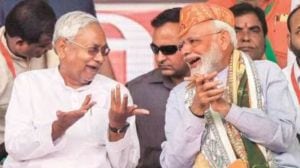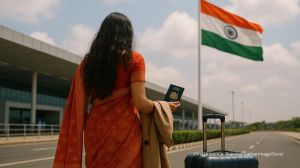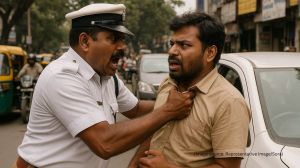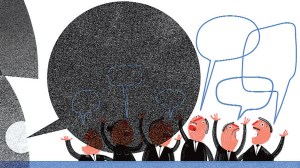‘I have no interest in anyone’s career except mine’
He has apologised to Big B and warmed up to Karan Johar. He says Aishwarya can act. And after Sarkar Raj and Contract, a sober Ram Gopal Varma is making another Sholay.

He has apologised to Big B and warmed up to Karan Johar. He says Aishwarya can act. And after Sarkar Raj and Contract, a sober Ram Gopal Varma is making another Sholay.
Is your forthcoming film, Sarkar Raj, a sequel to Sarkar? Both have the same protagonist.
Sarkar Raj doesn’t take off from where Sarkar ended, nor is it based on the Enron crisis or the Narmada Bachao Andolan as rumoured. A charismatic leader such as Subhash Nagre (Amitabh Bachchan’s character), responsible for so many lives, keeps getting into complex situations. In Sarkar Raj, you have a new set of situations. I would call it the further adventures of the Sarkar family.
Are more adventures on the anvil?
Sarkar 3 won’t happen because of certain incidents in Sarkar Raj.
You have called Abhishek Bachchan a better actor than Amitabh. Why?
Amitabh Bachchan came up the hard way. His journey from actor to star to superstar has included experiences that have enriched him as a person. These are reflected in his performances. Abhishek grew up as the son of a superstar. His connection with the common man was thus far lesser than that of his father. Yet he’s able to grasp a character’s emotional intensity with as much sensitivity and that calls for greater credit. That prompted me to call him a better actor.
Even Aishwarya has bowled you over in your first film with her.
Call me arrogant, but I cast Aishwarya in Sarkar Raj only because her looks suited the character. Not once did I think about her acting. That’s because her popular films such as Devdas have focused more on how beautiful she’s looked in them instead of her performance. But while working with her, I was taken aback by her performance. Her ability to slip in so easily into the raw, rugged realism of Sarkar Raj has impressed me.
What prompted your apology to Amitabh Bachchan at Sarkar Raj’s trailer launch?
Many people don’t know that Mr Bachchan thought Aag was a wrong step and told me not to re-make Sholay. But I pressured him to be a part of it. Just because he couldn’t say ‘no’, he reluctantly agreed and did everything the way I asked him to. His dignity prevented him from publicly mentioning that he never wanted to do the film. He was protecting me. So a public apology was due.
You seem to have finally warmed up to Karan Johar after all those media spats. Does that include his films too?
It’s nothing to do with warming up. I don’t see Karan Johar’s films not because they are his films, but because I don’t want to go to weddings or parties. Since that’s what happening in his films most of the time, I almost feel I am at a wedding when I watch them. I don’t like it, but there are millions who like it. Good for him.
Much before Sarkar, The Godfather influence was apparent in one of your earliest films, Gaayam (1993). How abiding an influence has Coppola been?
I first read The Godfather, the book, when I was in my intermediate. A friend had given it to me saying page 25 had an explicit sex scene. I read that page but after that, I read the whole book, which influenced my filmmaking, story-writing and above all, my understanding of characters. So a degree of Godfather is in every film of mine, including my debut Shiva. The book’s characters can always be put in completely different situations.
So, is Mario Puzo’s book, not Francis Ford Coppola’s film, the real inspiration for Sarkar?
Definitely. The book’s tone is more intense than Mr Coppola’s interpretation. Thus, Sarkar Raj has no connection to The Godfather: Part II or The Godfather : Part III.
Which director has inspired you the most?
Steven Spielberg, from whom I have learnt editing a frame on camera for dramatic impact and using the background score to tell something about the story which a script won’t.
Your factory has spawned many in-demand directors/writers such as Madhur Bhandarkar, Sriram Raghavan, Anurag Kashyap, Shimit Amin and Jaideep Sahni . How do you spot talent?
The word talent is a big misnomer. Filmmaking is an expression of your personality in its purest form. So, I don’t look for talent. I take a call on a person’s passion to tell a story, his seriousness and how intensely he wants to do it. It’s a big misconception that I give breaks to people. I am not interested in anybody’s career except my own. I use them in my films or hire them to direct a film for me. What they do beyond my film or with their life is of no interest to me. I have no favourite discoveries and don’t follow their careers after they leave me.
From Sridevi, Revathi and Urmila Matondkar to Antara Mali and Nisha Kothari, your choice of actresses is going downhill.
Urmila had five consecutive flops before Rangeela, yet why did the audience like her in it? Because things fell in place. The role was perfect for her and she did it marvellously. If any actress or actor was bad in my film, I am to be blamed too. I made a very good film in Satya and I completely screwed it up with Daud, just like I screwed up again with Aag after Sarkar. Such things can happen with an actor too. There is nothing like a bad or a good actor; he or she might come out bad, which is subject to how a film is made.
How come you are planning another Sholay remake after the flak Aag got?
In Company, Mohanlal tells Vivek about the underworld, “Yeh tumhare dhande ki jaat hai. I’d say the same thing to the media. I equally enjoy your brickbats and your fond nicknaming of me as ‘Ramu’. As regards re-making Sholay, for me, a film is an idea you execute. If making it in a certain way doesn’t work, you want to pitch it in another way, because the idea is good. For instance, when Drohi didn’t work, I remade it into Satya. Nobody realised that because Drohi was so badly packaged. When Raat didn’t work, I made Bhoot, which worked and I might do it once more in a different way. I am not one of those filmmakers who insist on standing by their bad films. I think it’s egoistic to say, “I stand by my film”.
Your next film Contract is on the underworld. Does it complete your underworld trilogy after Satya and Company?
It could. Satya dealt with small-time gangsters, Company was about the top rung and Contract explores the link between underworld and terrorism. The underworld has changed. In 1998, there were 108 underworld-related shootouts. In 2006, there were six, which means that the underworld has changed. They have become a conduit for terrorist networks. They supply terrorists with local intelligence, safe houses and transit routes.
Five films you would like to take with you if you were marooned on an island?
Mackenna’s Gold, The Exorcist, The Sound of Music, Sholay and maybe a porn film.



- 01
- 02
- 03
- 04
- 05




























